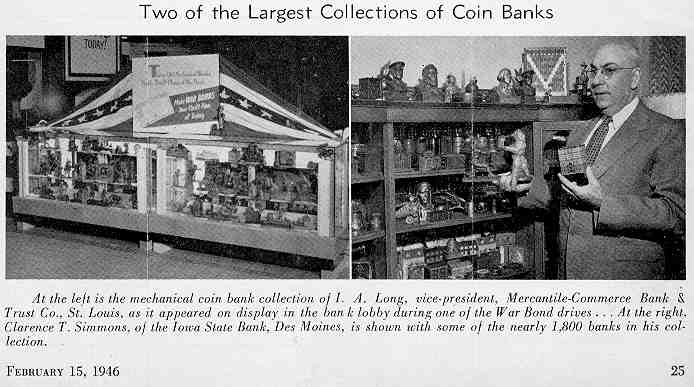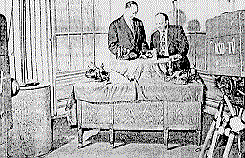BANK NEWS BANKERS AND THEIR HOBBIES
COLLECTORS OF COIN BANKS
I. A. Long, St. Louis, Has Large Collection Of Mechanical Banks
Clarence T. Simmons, Of
Des Moines, Specializes in "Still" Banks
By HAZEL HOPKINS, Assistant Editor, February 15, 1946

MANY bankers have hobbies that have nothing to do with their business and so when one does find a hobby that seems particularly appropriate for bankers it is heartening to learn that it is, indeed, one that has more than its share of banker enthusiasts. Such a hobby is that of collecting mechanical and "Still" coin banks.
There are two types of coin banks that bankers collect. One, and by far the most expensive hobby, is the mechanical penny bank that flourished from 1868 to the 1900s. The other type of bank favored by collectors is the "still" banks, or those that have no mechanical features and which include the fancy molded designs and the savings type of bank given by banks to their savings customers.
BANK NEWS recently heard of banker collectors of both types of banks. The collector of mechanical banks is I. A. Long, vice-president, Mercantile-Commerce Bank & Trust Co., St. Louis, and the collector of "still" banks is Clarence T. Simmons, former bank examiner, and now with the Iowa State Bank, Des Moines, Iowa.
Before telling of Mr. Long’s collection it would perhaps be wise to explain for the benefit of the uninitiated that a mechanical bank is one that moves. For instance, in the "Milking Cow" bank you put a penny in a slot in the cow’s back, press a lever and up goes Bossie’s right hind leg,, kicks the milker, who falls over backward with the milk pail over his head. Wondrous and somewhat awesome are some of these mechanical contrivances, especially Jonah and the Whale, and the Dentist and His Patient. Jonah is swallowed by the whale when a penny is inserted in the slot. In the Dentist and the Patient, the dentist pulls the patient’s tooth and the patient’s foot pushes the penny into the bank. The bank always gets the penny — the contributor always gets a laugh.
Mr. Long started his collection with two mechanical banks that he owned when a child. A few years ago his father sent him a newspaper article on the subject and he started a collection himself. He now owns 105 old mechanical banks which were patented by the United States, some of which were also patented in Canada and England. The oldest patent is dated 1869, which was for the manufacture of the Halls Excelsior Bank.
Patents were issued to approximately 270 different types of banks between 1869 and 1910, a number of which were never manufactured, or perhaps were manufactured in such small number that they have not shown up to date. When a collector does find one of these banks he has a real treasure.
Mr. Long recently acquired a Buster Brown and Tige Shoot the Chutes bank which is one of the rarest of old banks. It was discovered on the shelf of a small country store, where it had been for more than forty years. Other rare banks in Mr. Long’s collection are: Circular Bank Building with Cupola; Girl Skipping Rope; Bucking Buffalo; Milking Cow; Bird on Roof; extremely tiny organ; Squirrel and Tree Stump and Chronometer.
Mr. Long acquires his banks by correspondence with collectors all over the country. Prices range from $3 to $10, but collectors will pay over $100 for the rare banks. Mr. Long’s collection of mechanical banks was on display in the lobby of the Mercantile-Commerce Bank & Trust Co. during the Sixth War Loan Drive, where it created much interest among the customers.
Clarence Simmons of the Iowa State Bank has been collecting banks for a number of years. To date he has 1,791 banks, all of them given to him. He has received 51 banks from Kansas bankers; 53 from Missouri banks; 32 from Oklahoma, 88 from Texas, and 33 from Nebraska. He has in his collection coin banks from every state in the Union and from Canada, Hawaii, Bermuda, and Australia.
Mr. Simmons’ collection is varied. He has some mechanical banks, such as the Monkey and Organ Grinder, and the Indian and Bear; however, many kinds of coin banks and savings banks issued by banks to their customers are in his collection. He has banks that are shaped in the form of almost every conceivable object ranging from barrels and books to globes, liberty bells, nest eggs, replicas of General MacArthur, Washington, Lincoln, and Lindbergh. Some of the more fanciful designs in his collection are molded to represent the Golden Goose, Treasure Chest, Clocks, Magic Watches, Storks, Kittens, Beehives, and Airplanes. He is constantly adding to his collection and by the time this story appears in print his collection probably will number an even 1,800 banks.
Some other bankers who own collections of mechanical and coin banks are Andrew Emerine, president of the First National Bank, Fostoria, Ohio, whose collection is rated one of the finest in the country. It is displayed in glass cabinets on the bank’s mezzanine floor. Mr. Emerine is the proud possessor of a rare Pugfrog bank, which collectors will pay as much as $100 to possess. He also owns a rare Freedman’s Bank, which rumor says he refused to part with for a reported $750.
Among other rare collections are those of the late Elmer Rand Jacobs, executive vice-president of the Seaman’s Bank for Savings, New York, and the Boston Five Cents Savings Bank’s collection of former president, Wilmot Evans, Jr. At Houston Texas, the Gilbraltar Savings and Building Association has about 125 banks on display. Walter Godlove, assistant secretary, is caretaker of the collection. He has put several of the cases on wheels and plans to take them to civic clubs and schools for exhibition purposes.
With so many banks on display, and with so many people looking at them thinking how much fun it would be to make the "bird fly out of the tree" or the "bullfrog swallow" the penny, maybe some enterprising manufacturer will start making mechanical banks for children again. Of course, such a step could complicate matters for collectors, as even now there is a brisk trade in adding age to new banks and pawning them off on the unwary as collector’s items, yet if the children of the ’70s to ’90s found it easy to save their pennies in attractively molded or mechanical gadgets, perhaps the children of today would fall for the same idea. Mr. Long believes they will and says that his son and daughter, aged four and five, put all their pennies in his banks. Maybe a new crop of mechanical banks will see Superman leap through the air; Tarzan beat his chest; or Sinatra open his mouth and a Bobby Soxer swoon.
HOBBIES Magazine, October 1947
COLLECTOR
DEMONSTRATES BANKS
VIA TELEVISION
An event of unusual
interest took place in St. Louis when I. A. Long, vice-president of the
Merchantile-Commerce Bank and Trust Co. presented some of the rare merchantile
banks of his collection over Television Station KSD-TV. Mr. Long was interviewed
by Mr. Frank Eschen, director of Special News Events over Station KSD and
Station KSD-TV. In the course of the interview Mr. Long demonstrated the
mechanical action of many famous banks.
The photo below shows Mr. Long at left, and Mr. Eschen during the television
broadcast.
The value of such banks depends upon their scarcity and not particularly upon
their age, and many banks well known to collectors were exhibited. The first
cast iron mechanical banks were made in 1869, some of which reflect various
phases of American life until the early part of this century. There are
collections of these banks in several museums, and outstanding private
collectors have included the late Henry Ford and Walter P. Chrysler.

I. A. Long, Interviewed by Frank Eschen,
over Stations KSD and KSD-TV, St. Louis, Mo.
